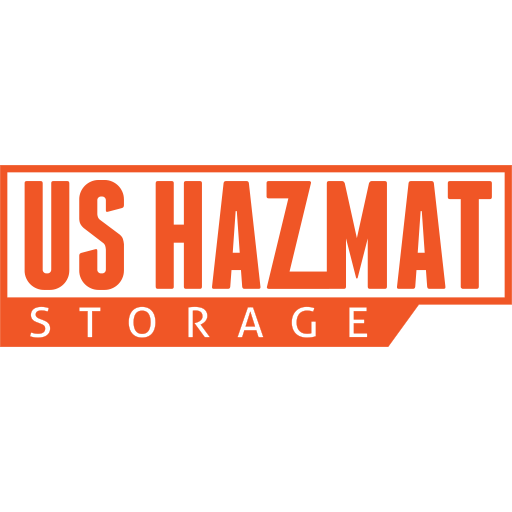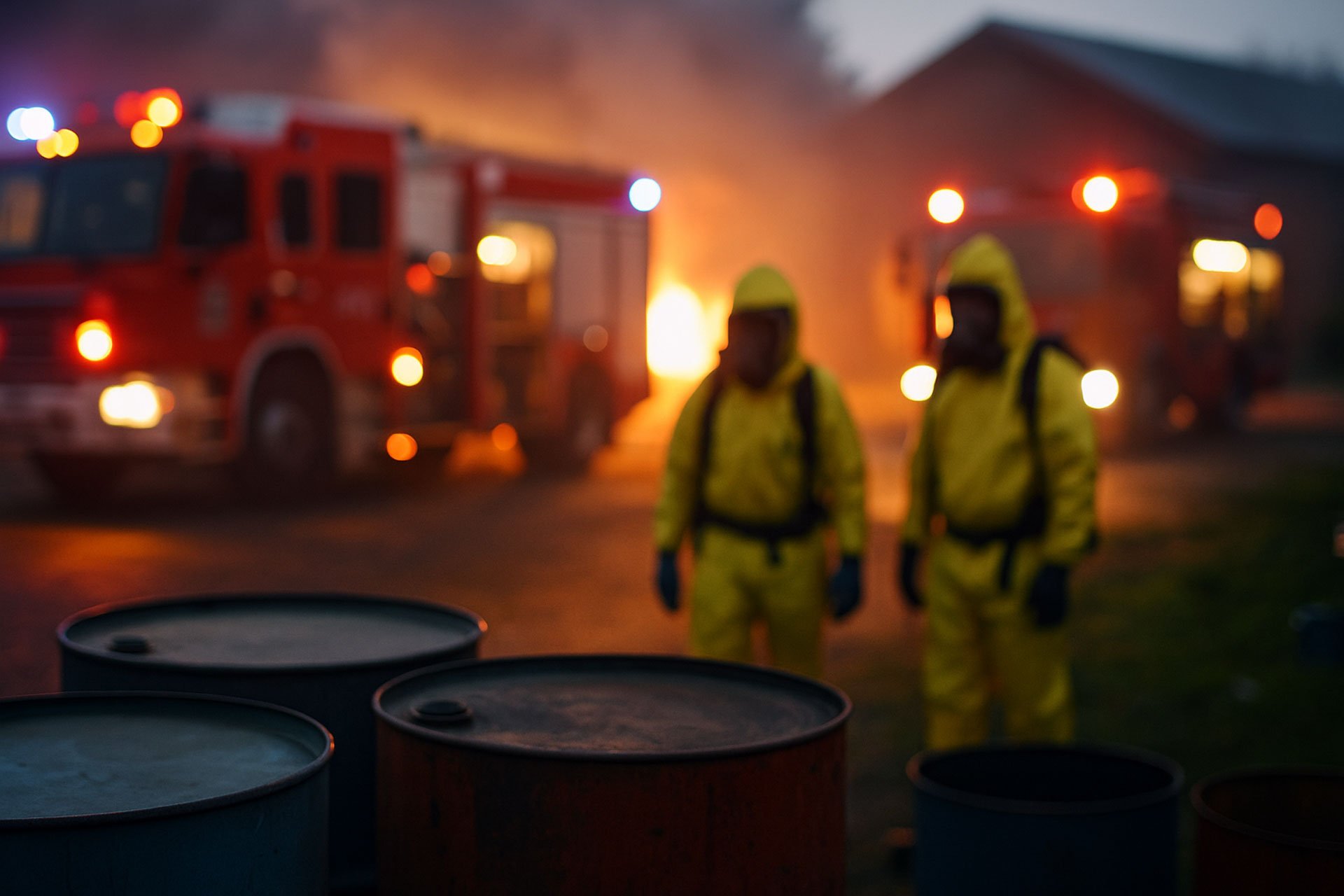Rogers County Barrel Explosion Sparks Urgent Reminder About Chemical Drum Safety
By US Hazmat Safety Editorial Team — July 10, 2025
On July 4, 2025, a catastrophic barrel explosion rocked a property off Highway 66 near Highway 410 in Rogers County, Oklahoma, leaving two men critically injured. The incident occurred while the individuals were cutting into a 55-gallon drum that had previously contained windshield wiper fluid—an act that quickly turned tragic.
The force of the blast was so intense that one of the men, identified as Gerald, was thrown across the yard and immediately caught fire. His friend Larry, standing nearby, also sustained extensive burn injuries. Emergency responders quickly closed off the highway to allow a medical helicopter to land and airlift Gerald, who suffered third-degree burns over 60% of his body. Larry was transported via ambulance with third-degree burns on roughly 30% of his body. Both men remain hospitalized in critical condition.
According to Rogers County Sheriff Scott Walton, this explosion could have been avoided entirely. “Cutting into a barrel that held flammable liquid—even if it’s been sitting empty for a while—is incredibly dangerous,” Walton told local media outlets. “These kinds of accidents are unfortunately not uncommon, and they are absolutely preventable.”
Multiple Oklahoma news outlets, including News on 6 and KTUL ABC 8, have covered the incident extensively, citing the same pattern of oversight: containers previously used to store flammable liquids can retain enough vapor to create an explosive atmosphere—especially when punctured or cut with high-heat tools.
The Hidden Dangers of “Empty” Hazmat Drums
The Rogers County explosion is, unfortunately, a textbook example of why hazardous material containers should never be handled casually—even if they appear to be empty. Windshield washer fluid commonly contains methanol, a volatile and flammable substance. Methanol vapors can remain in a sealed or even unsealed container long after the visible liquid has evaporated. When exposed to sparks or cutting torches, these vapors can ignite explosively.
“Many people wrongly assume an empty drum is harmless. That misconception can cost lives,” said a representative from the US Hazmat Safety team. “The fumes left behind can be far more dangerous than the liquid itself.”
According to OSHA and the National Fire Protection Association (NFPA), even trace amounts of flammable or combustible materials can create hazardous conditions. Drums, totes, and intermediate bulk containers (IBCs) that once held Class I or II flammable liquids are especially dangerous if not professionally decontaminated.
What Went Wrong In Roger County?
In the Rogers County case, the two victims were attempting to repurpose or dispose of a chemical drum by cutting into it. It’s unclear whether they knew the drum had contained a flammable fluid, but the explosion illustrates a fundamental misunderstanding of chemical storage and residual vapor hazards.
Sheriff Walton confirmed, “This wasn’t a fire; it was a full detonation. And the explosion was so violent that one of the victims landed nearly 20 feet from the barrel.”
Such outcomes are unfortunately familiar to safety professionals, who often encounter unsafe drum handling procedures in industrial yards, mechanic shops, or residential settings.
Preventing Hazardous Explosions: Best Practices for Drum Safety
At US Hazmat Storage, our mission is not only to provide compliant hazardous material storage buildings but to educate industry professionals and workers about the dangers of mishandling chemical containers. The Rogers County incident serves as a critical reminder of the importance of following proven safety and compliance protocols.
Here are key best practices for managing empty drums that previously contained hazardous substances:
1. Treat Empty Drums as Hazardous Until Proven Safe
Never assume a container is safe just because it appears dry. Vapors can linger and form explosive concentrations, especially in warm environments or sealed conditions.
2. Decontamination Hazardous Storage Drums Before Disposal
All chemical drums must be decontaminated following EPA and OSHA standards. This includes:
All chemical drums must be decontaminated following EPA and OSHA standards. This includes:
- Triple-rinsing or using neutralizing agents
- Using explosion-proof air movers or vacuum systems for vapor removal
- Proper venting and drying before cutting or crushing operations
3. Clearly Label Hazard Material Status
Even after decontamination, containers should be clearly labeled:
- “Decontaminated – Safe for Recycling”
- Or “Hazardous – Requires Certified Disposal”
Improper or absent labeling is a major contributor to workplace accidents.
4. Use Only Approved Hazards Material Handling Tools
Cutting into drums, if absolutely necessary, should only be performed with non-sparking tools in a well-ventilated area, and only after confirming that the container is fully vapor-free. A hot torch or grinder is never appropriate for sealed containers.
Cutting into drums, if absolutely necessary, should only be performed with non-sparking tools in a well-ventilated area, and only after confirming that the container is fully vapor-free. A hot torch or grinder is never appropriate for sealed containers.
5. Training and Hazard Recognition
Workplaces handling chemical drums must provide employees with:
Workplaces handling chemical drums must provide employees with:
- Hazard Communication Standard (HCS) training
- Drum decontamination procedures
- Emergency response drills
- Permit-to-work procedures for any modification to former chemical containers
Regulatory Guidance and Enforcement
The Occupational Safety and Health Administration (OSHA) regulates the handling of hazardous waste and chemical drums under multiple codes, including:
- 29 CFR 1910.120 – Hazardous Waste Operations and Emergency Response (HAZWOPER)
- 29 CFR 1910.106 – Flammable Liquids
- NFPA 30 – Flammable and Combustible Liquids Code
These codes are not just compliance boxes—they’re lifesaving guidelines that provide structure for managing hazardous materials and waste responsibly.
US Hazmat Storage encourages all clients and partners to integrate these standards into their internal safety programs. Our team provides consultation and engineering support to help businesses meet and exceed these requirements.
How US Hazmat Storage Can Help
US Hazmat Storage offers fire-rated chemical storage buildings, mobile hazmat lockers, and compliant containment systems for flammable liquids, corrosives, and combustibles. But our solutions go beyond containment—we offer:
- Consulting and Site Planning for chemical handling safety
- FEMA and NFPA-Compliant Storage Buildings
- Remote Deployment Options for emergency and temporary operations
This tragic explosion illustrates just how easily a routine task can turn deadly when chemical safety is neglected. The price paid in Rogers County is a sobering reminder that safety protocols must be observed at all times—whether on a construction site, in a warehouse, or at home.
Final Thoughts
The July 4th incident should never have happened—but its story could help save lives moving forward. Through education, compliance, and proper handling of chemical containers, we can prevent future injuries and tragedies.
At US Hazmat Storage, we’re here to support your facility’s safety and compliance needs—because “empty” doesn’t mean safe.
For more information on hazmat safety protocols and compliant chemical storage buildings, visit ushazmatstorage.com.


